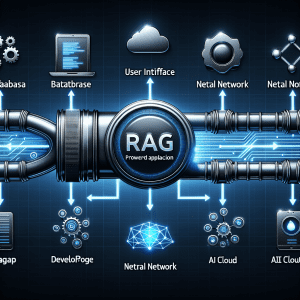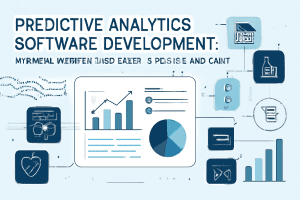Introduction
The manufacturing industry is undergoing a massive transformation, thanks to digital technologies such as Artificial Intelligence (AI), Machine Learning (ML), Internet of Things (IoT), and Predictive Analytics. In the past, factories relied heavily on reactive maintenance, manual monitoring, and limited visibility across operations. But today, manufacturers are leveraging data-driven insights to improve efficiency, reduce downtime, and boost profitability.
At the center of this revolution lies Predictive Analytics—a powerful technique that uses historical and real-time data to forecast future outcomes.
According to MarketsandMarkets, the predictive analytics market is expected to reach $28.1 billion by 2026, growing at a CAGR of 21.7%. Much of this growth is fueled by the manufacturing sector, where predictive analytics helps companies anticipate problems, optimize production, and stay competitive in a global marketplace.
This blog explores the 10 key use cases of predictive analytics in manufacturing—and the benefits each brings to the table.
What is Predictive Analytics in Manufacturing?
Predictive analytics involves analyzing historical data, real-time data, and external factors to identify patterns and predict future outcomes. In manufacturing, it combines IoT sensors, machine learning algorithms, and advanced statistical models to forecast:
-
Equipment failures
-
Demand fluctuations
-
Quality issues
-
Supply chain risks
Instead of reacting to issues after they occur, manufacturers can now prevent problems before they happen.
Benefits of Predictive Analytics in Manufacturing
Before diving into the use cases, let’s highlight some universal benefits:
-
Reduced Downtime: By predicting equipment failures, factories minimize unplanned shutdowns.
-
Lower Maintenance Costs: Shifting from reactive to predictive maintenance saves money.
-
Improved Product Quality: Detecting defects early prevents large-scale waste.
-
Optimized Supply Chain: Data-driven demand forecasting reduces inventory issues.
-
Increased Productivity: Efficient operations ensure maximum output with fewer resources.
-
Enhanced Customer Satisfaction: Delivering on time with consistent quality builds trust.
-
Data-Driven Decision Making: Real-time analytics empowers management to act proactively.
Now, let’s explore 10 powerful use cases.
10 Use Cases of Predictive Analytics in Manufacturing
1. Predictive Maintenance
Problem: Traditional maintenance schedules are either too frequent (wasting resources) or too late (leading to breakdowns).
Solution: Predictive analytics uses IoT sensor data (temperature, vibration, sound) to detect anomalies in equipment performance.
Benefit: Manufacturers can service machines only when needed, reducing downtime and extending asset lifespan.
Example: General Motors uses predictive analytics to monitor assembly line robots, preventing costly shutdowns.
2. Demand Forecasting
Problem: Overstocking ties up capital, while understocking leads to missed sales.
Solution: Predictive models analyze past sales, seasonal trends, and market conditions.
Benefit: Accurate forecasts align production with demand, reducing waste and storage costs.
Example: Coca-Cola uses predictive analytics to forecast demand for different beverage categories across global markets.
3. Quality Control and Defect Detection
Problem: Manual quality checks are time-consuming and prone to errors.
Solution: Predictive analytics processes real-time production data to spot deviations that may cause defects.
Benefit: Early detection prevents defective products from reaching customers.
Example: BMW uses predictive analytics to monitor welding processes and reduce defects in vehicle assembly.
4. Supply Chain Optimization
Problem: Supply chains face disruptions due to delays, shortages, or global crises.
Solution: Predictive analytics monitors supplier performance, transport delays, and raw material availability.
Benefit: Manufacturers gain resilience, reducing risks of bottlenecks.
Example: Toyota uses predictive analytics to optimize its just-in-time supply chain model.
5. Energy Management
Problem: Energy consumption is one of the largest expenses in manufacturing.
Solution: Predictive models analyze energy use patterns and suggest optimizations.
Benefit: Reduced energy costs and improved sustainability.
Example: Siemens uses predictive analytics to optimize energy usage across smart factories.
6. Inventory Management
Problem: Overstocking and stockouts disrupt production.
Solution: Predictive models ensure optimal stock levels by analyzing demand and lead times.
Benefit: Reduced holding costs, improved cash flow, and uninterrupted production.
Example: Unilever uses predictive analytics to balance inventory across global warehouses.
7. Workforce Optimization
Problem: Labor shortages and high turnover affect productivity.
Solution: Predictive analytics forecasts staffing needs based on demand and machine usage.
Benefit: Right number of workers at the right time improves efficiency.
Example: Foxconn uses predictive models to optimize workforce schedules in its electronics factories.
8. Equipment Lifecycle Management
Problem: Manufacturers struggle with knowing when to replace vs. repair machinery.
Solution: Predictive analytics provides lifecycle predictions based on usage patterns.
Benefit: Helps plan capital expenditures and reduce unexpected failures.
Example: Aerospace manufacturers use predictive analytics to monitor jet engine lifecycle performance.
9. Safety and Risk Management
Problem: Industrial accidents lead to costly downtime and legal consequences.
Solution: Predictive analytics analyzes workplace data (incidents, sensor readings, environmental factors).
Benefit: Prevents accidents by alerting managers to unsafe conditions.
Example: Oil & gas companies use predictive analytics to prevent equipment-related hazards.
10. Product Innovation and R&D
Problem: Developing new products is costly and time-consuming.
Solution: Predictive models analyze customer preferences, competitor trends, and material performance.
Benefit: Faster innovation with higher chances of market success.
Example: 3M uses predictive analytics in material science research to design new products.
Challenges of Implementing Predictive Analytics in Manufacturing
-
High Initial Investment: IoT sensors, data platforms, and analytics tools can be expensive.
-
Data Integration Issues: Many factories still use legacy systems.
-
Skill Gaps: Lack of data science expertise in manufacturing teams.
-
Cybersecurity Risks: Increased data collection requires stronger security protocols.
The Future of Predictive Analytics in Manufacturing
Looking ahead, predictive analytics will continue to evolve, supported by:
-
AI & Machine Learning: Smarter models for accurate predictions.
-
Edge Computing: Faster real-time analytics closer to machines.
-
Digital Twins: Simulating production processes to test improvements.
-
Sustainability Goals: Optimizing energy and reducing carbon footprint.
Manufacturers that embrace predictive analytics will gain a strong competitive edge in efficiency, innovation, and profitability.
Conclusion
Predictive analytics is no longer just a buzzword—it’s a game-changer for manufacturing. From predictive maintenance to product innovation, its use cases span across every stage of the production cycle.
By adopting predictive analytics, manufacturers can:
-
Reduce downtime
-
Improve quality
-
Optimize supply chains
-
Manage costs
-
Enhance customer satisfaction
The 10 use cases and benefits we explored show why predictive analytics is becoming the backbone of smart manufacturing.
As Industry 4.0 advances, manufacturers that ignore predictive analytics risk falling behind. Those who embrace it will lead the future of data-driven, efficient, and sustainable manufacturing.











